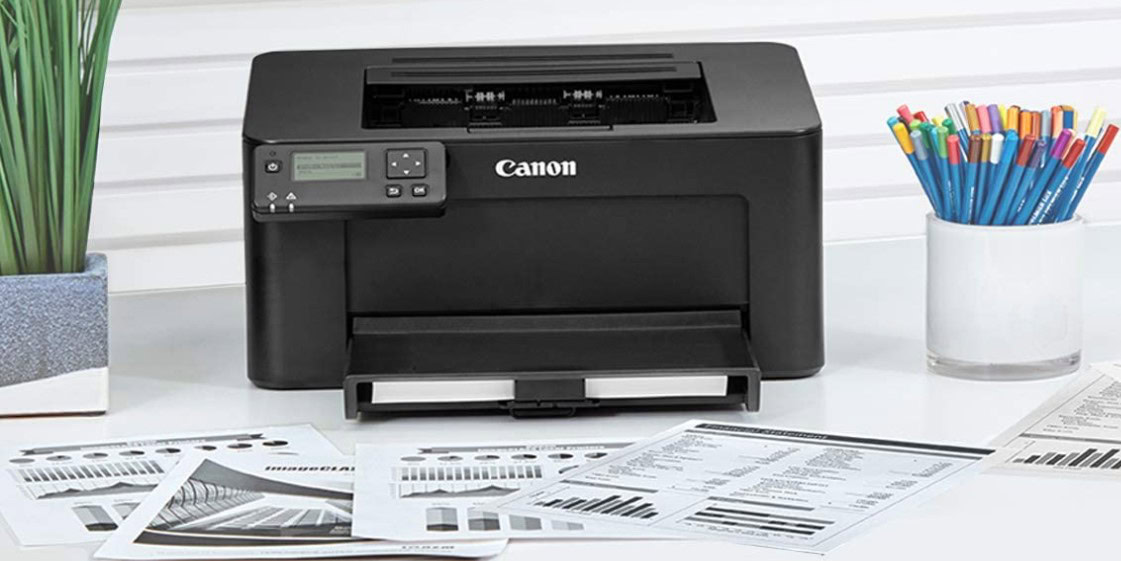Affiliate links on Android Authority may earn us a commission. Learn more.
Here's how to print from a Chromebook
Printing is old tech. However, people still need printed documents from time to time. Luckily, it’s not terribly difficult to do and requires you to do very little most of the time. The only time we had issues with printing on a Chromebook was when the printer was absolutely ancient and it was difficult getting the two devices to see each other. Otherwise, this is pretty straightforward stuff and you’ll be fiddling with cables more than your Chromebook.
Read more: What is a Chromebook and what can it do?
QUICK ANSWER
To print from a Chromebook, we recommend using your printer's wireless capabilities if it has it. From there, connect your Chromebook to the same Wi-Fi network and it should automatically see your printer. You can alternatively use a USB cable to connect directly to the printer and it should see it automatically from there.
JUMP TO KEY SECTIONS
What you’ll need to make this work
You’ll need some preparation before you get started. For the most part, these things are pretty obvious, but getting your setup in order before starting will dramatically reduce the potential issues that you run into.
- A printer — Obviously, you need a printer. You’ll want to make sure the printer is properly set up as per the manufacturer’s instructions and also connected to your home’s Wi-Fi network if it’s capable.
- A Chromebook — You’ll also need your Chromebook. If your printer is on a Wi-Fi network, your Chromebook needs to be on the same Wi-Fi network.
- A USB cable (optional) — Most printers have USB ports you can connect to in order to make a laptop from any operating system work with it. We’ll recommend a wireless connection, but you should have a USB cable that fits both your Chromebook and printer just in case.
It’s a pretty short list. That said, you wouldn’t believe how often people try to print from a printer that isn’t properly set up first. Each printer is different, so we recommend consulting your owner’s manual. You can Google Search the name of your printer along with “owner’s manual” and usually you can find a PDF of it online straight from the manufacturer.
How to print things from a Chromebook
Once you’re set up, printing something is usually pretty easy. It’s a two-step process and you should only need to do the first step once.
How to add a printer on a Chromebook
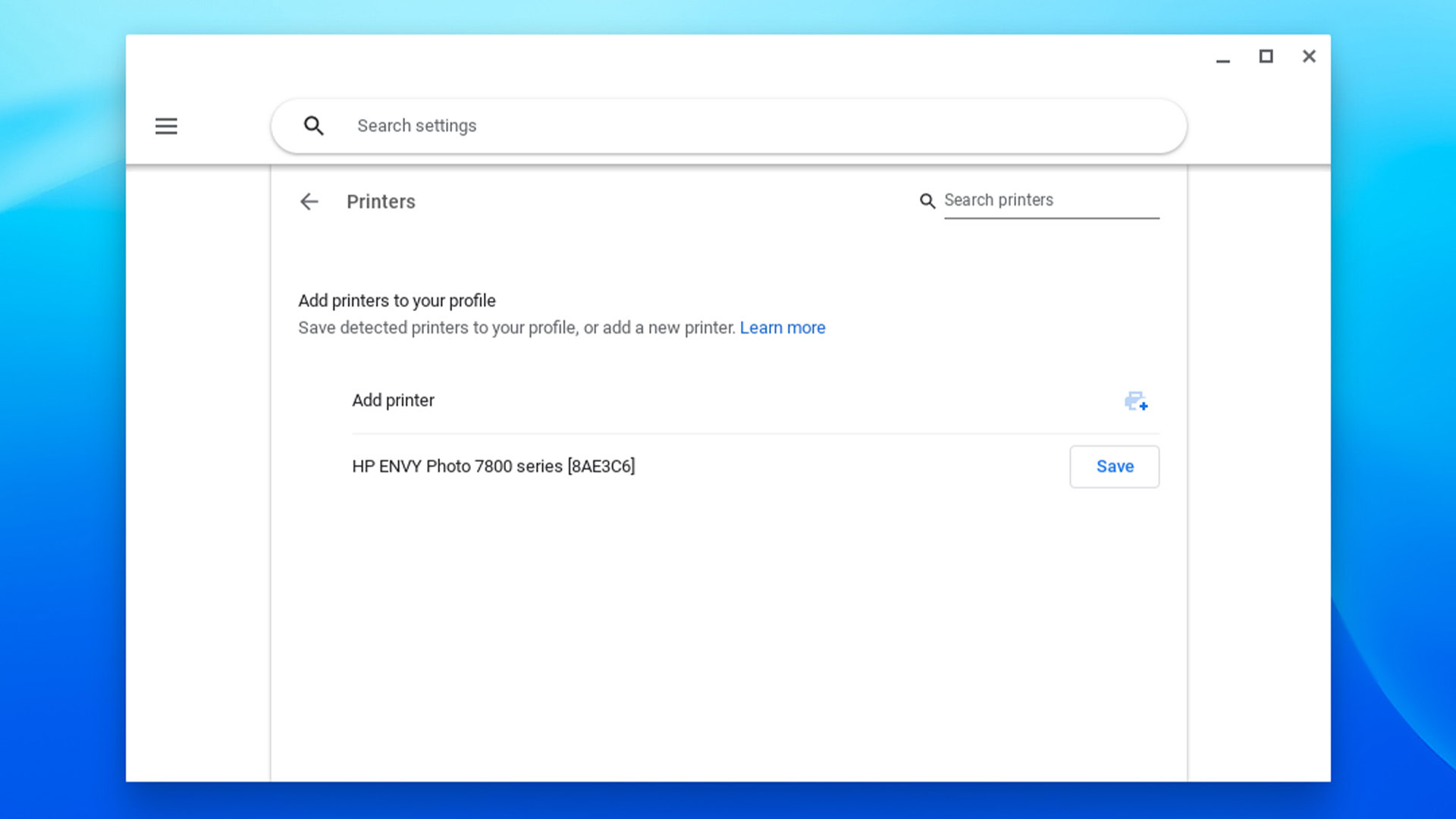
- For Wireless connections, make sure your Chromebook and printer are both on and connected to your home’s Wi-Fi network.
- On the Chromebook, open Settings and then scroll down to the Print and scan section.
- Tap Printer. On the next page, you should see your printer’s name.
- Tap the Save button to save the printer. You may get an error stating that the printer is no longer available. Just wait a few seconds and give it another try. It took my Chromebook three tries.
- Once done, your printer shows up under the Your saved printers heading. That’s it.
- This connects the printer for use across your entire Chrome OS experience. It should be available in every app that has print capabilities after this task is completed.
- Manual method — To manually add a printer, go into your Settings, then scroll down to Printers and click that. Tap the App printer icon. There, you can add your printer’s name, address, protocol, and queue settings. Tap the Print server option to enter a print server if needed.
For wired connections, connect your Chromebook to your printer via a USB port and then repeat the steps above starting from step two. Please keep in mind that you must perform the above steps either wired or wireless before you can proceed to the next step.
How to print things from a Chromebook
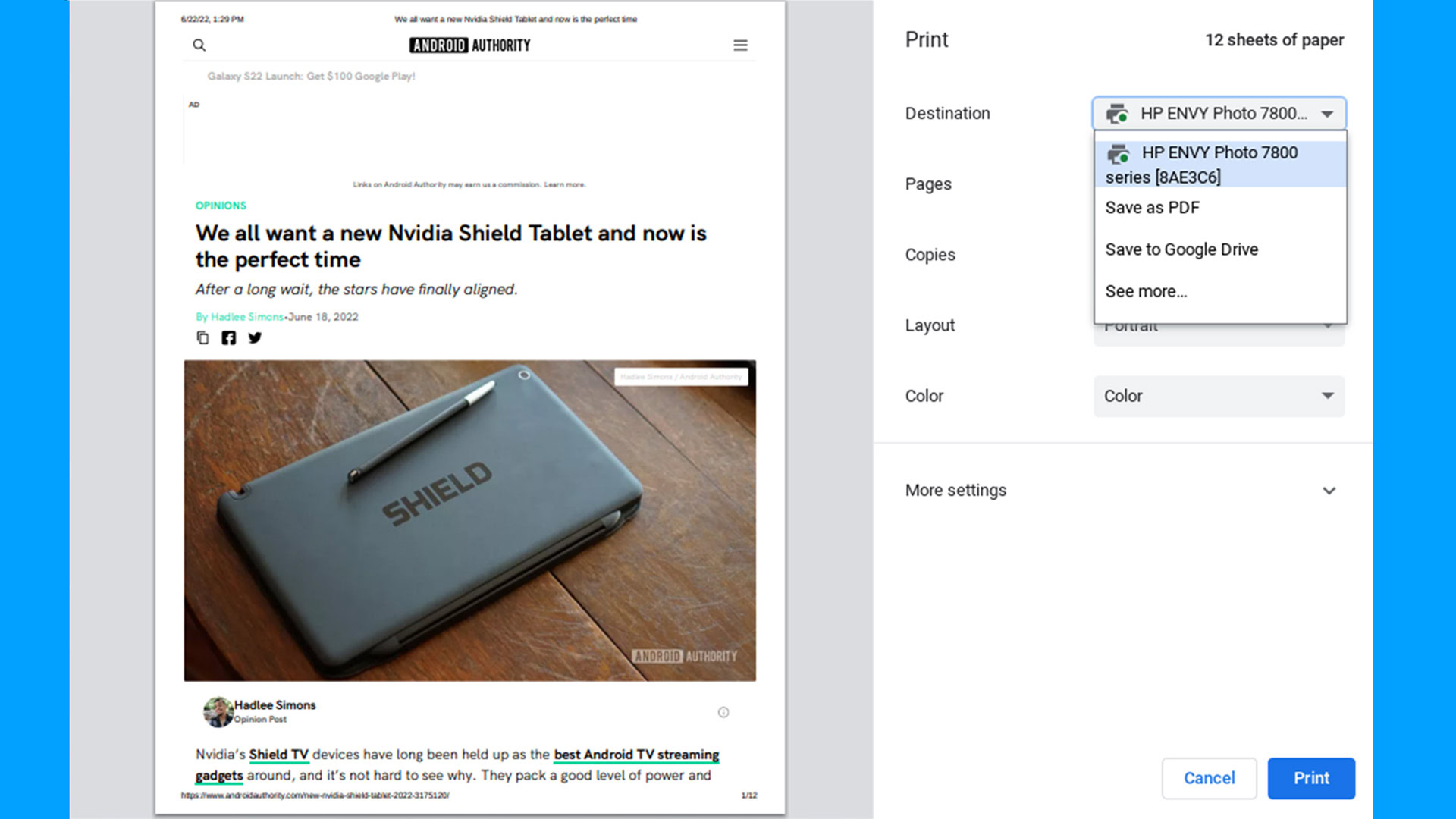
- Go to the webpage, document, or image you want to print.
- The vast majority of Android apps should have the print option in the same places. Either hit the 3-dot menu button and select Print, go to File, and then select Print, or use the universal shortcut, CTRL+P. One of those three options should work in any app capable of printing.
- When the print UI pops up, your printer should be selected as default where it says Destination.
- If not, tap the Destination drop-down and select See more. On the next screen, tap your printer. It should automatically reload the print UI with your printer selected.
- Tap the Print button to send it on its way. The default options should be just fine for printing basic stuff but continue to the next section if you have some extra things you need to do.
- Pro tip — If you’re using an app that doesn’t let you print for whatever reason, another option is to take screenshots and then print off the screenshots instead with Google Photos.
- Pro tip — You can see queued print jobs by going into the Settings on your Chromebook, then scrolling down to Print Jobs and clicking there.
Other print options on Chromebooks
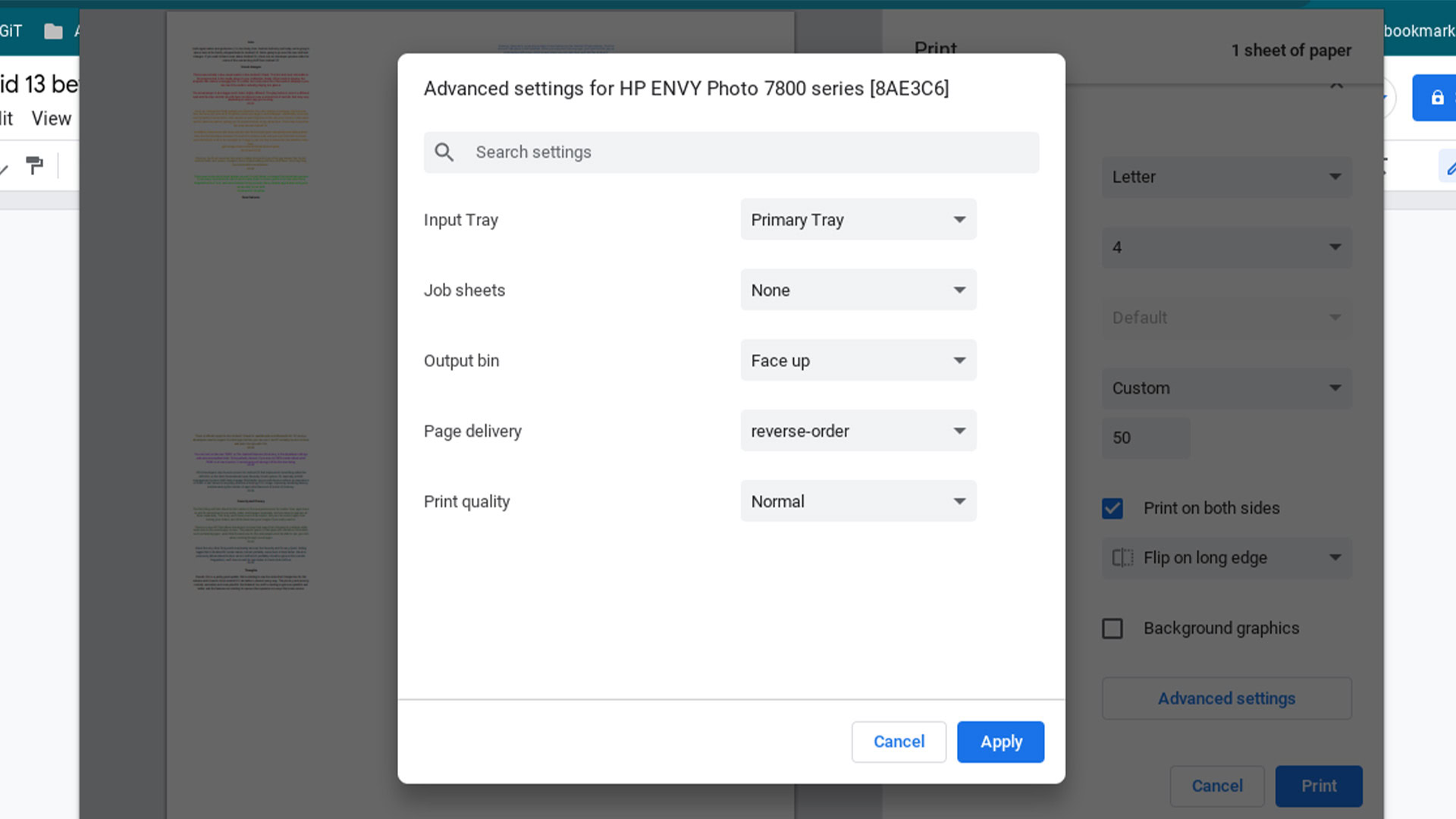
There are some other settings in the print UI. Here’s a quick primer on what they all do.
- Pages — Determines how many pages will print. You can select all pages or just the pages you want. For example, if you have an 11-page document, but you only need pages three, four, five, and eight, you would select the Custom option and type “3-5, 8” without the quotes.
- Copies — Lets you choose how many copies to print.
- Layout — You can use this to print your documents in portrait or landscape mode. Make sure to check this one if you’re printing photos because, on my Chromebook at least, it always defaults to portrait.
- Color — You can choose between a full-color print or just black and white.
Tap the More Settings option to access the options below.
- Paper size — Unless you use a special paper size, you can just leave this one at its default Letter setting. Tapping the drop-down gives you a metric ton of other paper size options.
- Pages per sheet — Gives you the ability to print multiple pages on a single sheet. For example, if you are printing a document, and you select four from the menu, it will print pages one through four on just one page.
- Margins — We recommend just leaving this at its default setting. However, this lets you determine how much blank space you get around the sides, top, and bottom of the paper when printing. The print UI changes based on your decision so you can see what it looks like before printing.
- Scale — Lets you scale the document or image to be larger or smaller on the page. It works on a % basis with 100% being the default. You can go above 100% to make it bigger or less to make it smaller. The preview UI changes based on your decision here too.
- Two-sided — Gives you the option to print on both sides of the page. This works great if your printer supports it, but can be janky if not. Once selected, you can choose if you want it to flip on the long edge like a book or on the short edge, which is less common.
- Options — Lets you decide if you want to print headers and footers along with background graphics. You can select or deselect the items based on your needs.
At the bottom of the print UI, you may see an Advanced settings button. Click it to get to the final few options. This did not show up on all prints during our testing so sometimes it might not be there.
- Input tray — Printers with multiple trays can use this to determine which tray. For example, my HP printer has a photo paper tray and I can select to use photo paper with this option.
- Job sheets — Job sheets are used in commercial applications. and you shouldn’t ever need them as a consumer. Professionals can select the option they need and they’ll know which one they need.
- Output bin — Usually the only option here is Face up, so don’t worry about this one. Printers that can print on both sides, such as office printers, usually have the option to print a document face up or face down.
- Page delivery — This setting correlates directly with the Output bin setting. If you’re printing Face up, then you want to keep page delivery as reverse-order. Those who print Face down should change this setting to same-order so the pages are in the proper order when you pick them up out of the tray.
- Print quality — Use this to determine how high quality you want your print to be. For the most part, Normal is fine, but professionals may want to use High when printing a final copy or Draft to print a low-quality copy to conserve ink.
The above options may be different depending on your printer. I have a fairly high-end printer with a dedicated photo paper tray so I have that option. Offices may have printers that can print on both sides simultaneously and those folks will have that option.
Read more: How to change the cursor on a Chromebook.
Troubleshooting tips and tricks
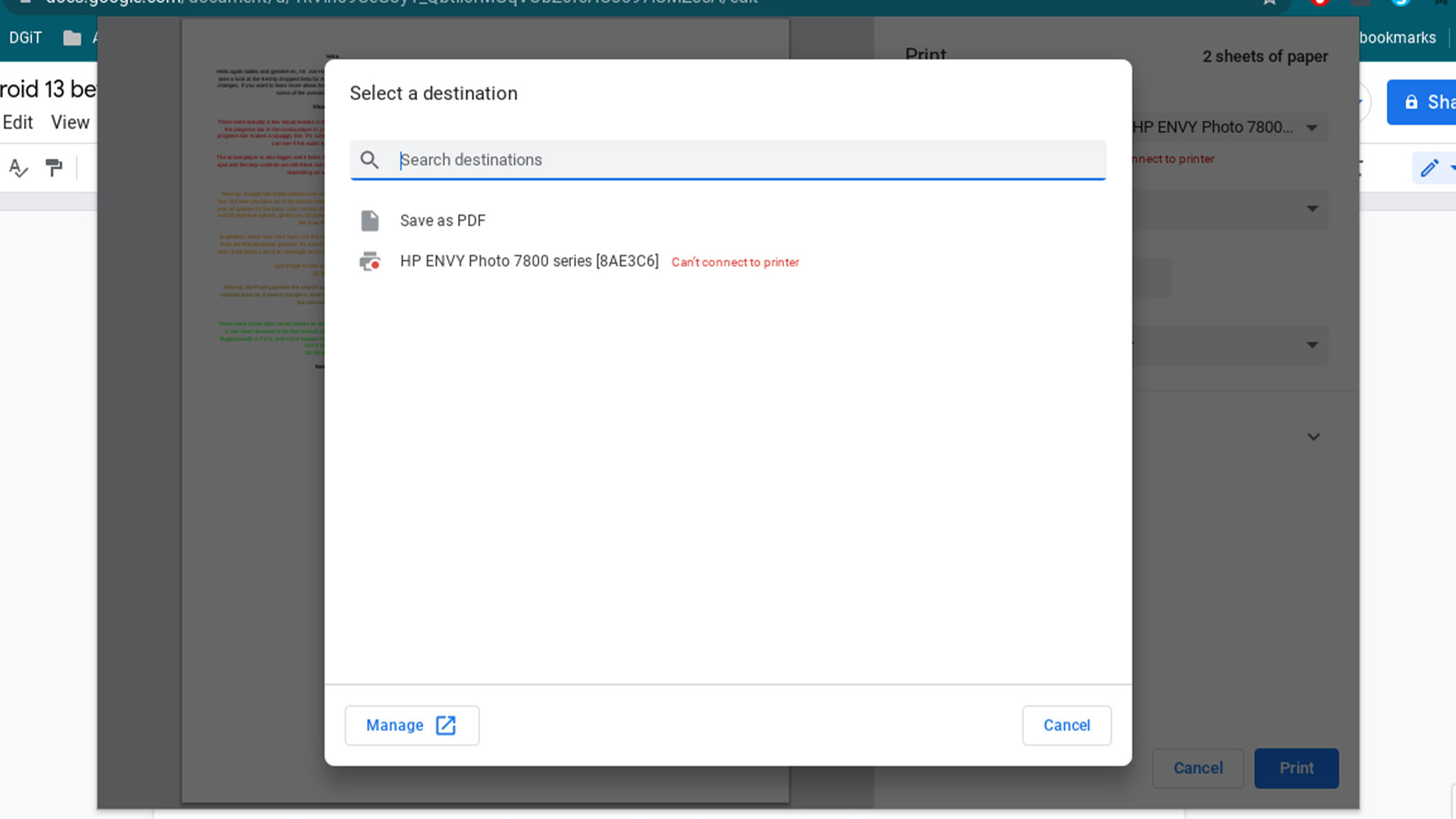
Things rarely work perfectly every time, so here are some common issues and how to potentially fix them.
- Can’t connect to printer wirelessly — There are many reasons why this might happen. To start, reboot your printer and Chromebook and try again. If that doesn’t work, try setting both devices on the same SSID. Sometimes, printers can only connect to 2.4Ghz connections while Chromebooks can do 5Ghz. It usually doesn’t matter, but it doesn’t hurt to try. Finally, double-check that your printer’s Wi-Fi is active and connected.
- Can’t connect to the printer with wires — Again, there are a variety of reasons why this might be. Try a different USB port on your printer and your Chromebook. Also, try a different USB cable if you have one.
- Printer isn’t showing up in Add a Printer — This is the same problem as not being able to connect. Try all of the above steps and see if that works.
- Printer is printing stuff weird — When you go to print, double-check all of your settings. Make sure it’s set to the proper orientation, paper size, and that it’s pulling from the correct tray if you have multiple trays on your printer.
- It’s taking forever to print stuff — This is usually an issue with the print queue. You can access your printer’s print queue on the machine itself. For Chromebooks, go into Settings, scroll down to Print Jobs and click it. You can see your Chrome print queue there where you can delete the queue and try again.
Up next: How to reset a Chromebook
FAQ
As long as the app is downloadable on a Chromebook, it should work as intended. That includes third-party print apps like Canon. Connecting your printer is a system-wide thing, so once you get it set up once, it should be usable in every app.
Unfortunately, you’ll need to get into contact with your IT department for help.
There isn’t one on the keyboard or anything like that. Most apps can print either through the 3-dot menu button or through File > Print. The universal shortcut is CTRL+P and that should work most of the time.
Go into your Chromebook’s Settings menu and scroll down to Print Jobs. Click that and you’ll see everything in your print queue.
You’ll want to use the page size, margin, and scale options to size your print for photo paper, labels, or whatever else you need.
Google Cloud Print was depreciated in December 2020, as per Google.
